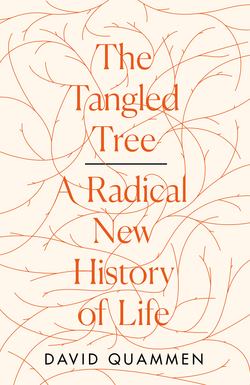Читать книгу The Tangled Tree: A Radical New History of Life - David Quammen, David Quammen - Страница 32
24
ОглавлениеGeorge Fox was no longer a rangy young man when I sat with him in a nondescript pizza parlor near the campus in Urbana, after the opening session of a Carl Woese memorial symposium, and watched him eat a nondescript little pizza. Fox is a man who prefers simple, plain food, and he had cringed when I ordered pepperoni and mushrooms on my own. At age sixty-nine, he carried the full body and slight jowls of a lifetime spent in laboratories and classrooms; wire-rim spectacles had replaced the dark horn-rimmed glasses he had worn in the 1970s photos, and his brown hair was graying at the temples, but his eyes still shined brightly blue as he recalled the days and years with Woese. Now a professor at the University of Houston, Fox had flown up for the Woese meeting, which was hosted by the Carl R. Woese Institute for Genomic Biology (its name reflecting the fact that Woese has become a venerated brand at the University of Illinois). Fox would give one of the invited talks.
He had spent his academic career at three institutions: Houston, for almost three decades; preceded by Illinois, as a postdoc with Woese; and before that it was Syracuse University, as an undergraduate and PhD student. The circumstances of Fox’s arrival in Urbana were haphazard, beginning from a coincidence in Syracuse, where Woese himself grew up. There at the university, Fox belonged to a professional engineering fraternity, Theta Tau, of which Carl Woese’s father—also named Carl Woese—was a founder, and so Fox was required to know the name. As he shifted interest from chemical engineering to theoretical biology, he noticed and became fascinated by some of the early work of Carl Woese the son. In particular, there was a paper on what Woese called a “ratchet” mechanism of protein production by ribosomes—a risky proposal, a wild and interesting idea (later proven wrong in its details), published in 1970. So Fox wrote to this ratchet guy asking for a postdoc fellowship, and Woese seemed to see the Syracuse connection as karma. He had a position to fill, yes, with the departure of Mitch Sogin, the ultimate handyman grad student, and he offered that to Fox.
“We did not discuss salary,” Fox said over his pizza and Coke. “He never sent me a letter offering the position. It was all completely verbal.” On such assurance, Fox got married and showed up in Urbana that autumn with his wife. Arriving unannounced, he encountered a man at the lab door, an unprepossessing figure in jeans and a drab shirt, with a chain holding a huge bunch of keys. “He looked like the goddamn janitor.” Fox gave his name and prepared to talk his way in. “No!? Welcome!” It was Woese.
“He sat me down in his office and …” Fox hesitated. “You got a piece of paper?” On a yellow sheet from my legal pad, he began sketching the layout of the lab. He drew a long rectangle and subdivided it. There were three major rooms, he explained, and the middle room, here, held the light table, where Carl usually worked. Linda Magrum and Ken Luehrsen were here, in the left room. Over here on the right side of the center room was Carl’s little personal office and the electrophoresis room. The radiation room and the darkroom were across the hall, and then storage, three more spaces barely bigger than closets. Woese gave Fox a table in his office, Fox said, with a door that stayed open, “so he could see me.” Like the young Luehrsen, only more so, as a postdoc, Fox was on probation.
At the beginning, Woese assigned him to assembling sequences from 5S rRNA, the shortest and least informative of the ribosomal RNA molecules, as a way of getting up to speed on what the lab was doing. That project yielded some unexpected results, impelling Woese to try to make Fox an experimentalist. But it wasn’t his forte, and he knew that. He wanted to do the sort of “theoretical stuff,” the deep evolutionary analysis of molecular data—what would now be called bioinformatics—that Woese himself did. Reading the code, drawing conclusions that went back three billion years and more. Woese, on the other hand, wanted him to generate data. “I was under a lot of pressure,” Fox recalled—the pressure of Woese’s expectations versus his own interests and skills. “What I had to do was, every other day, come up with a novel insight, so that he would continue to allow me to work on the sequence comparison project.” Failing that impossible standard, he was banished back to the lab, set to the tasks of growing hot cells and extracting their ribosomal RNA. But Fox continued, in flashes, to show his value to Woese as a thinker. Gradually he proved himself, not just sufficiently to work on sequence comparisons but well enough to become Woese’s trusted partner, as well as the sole coauthor on the culminating paper in 1977, with its announcement of a third kingdom of life.
